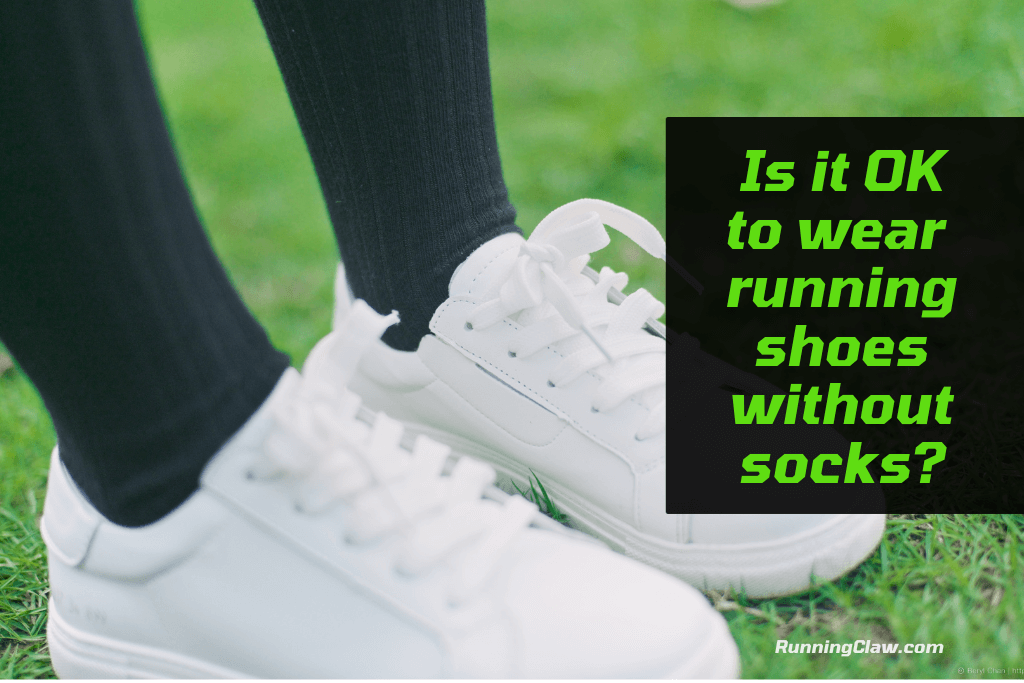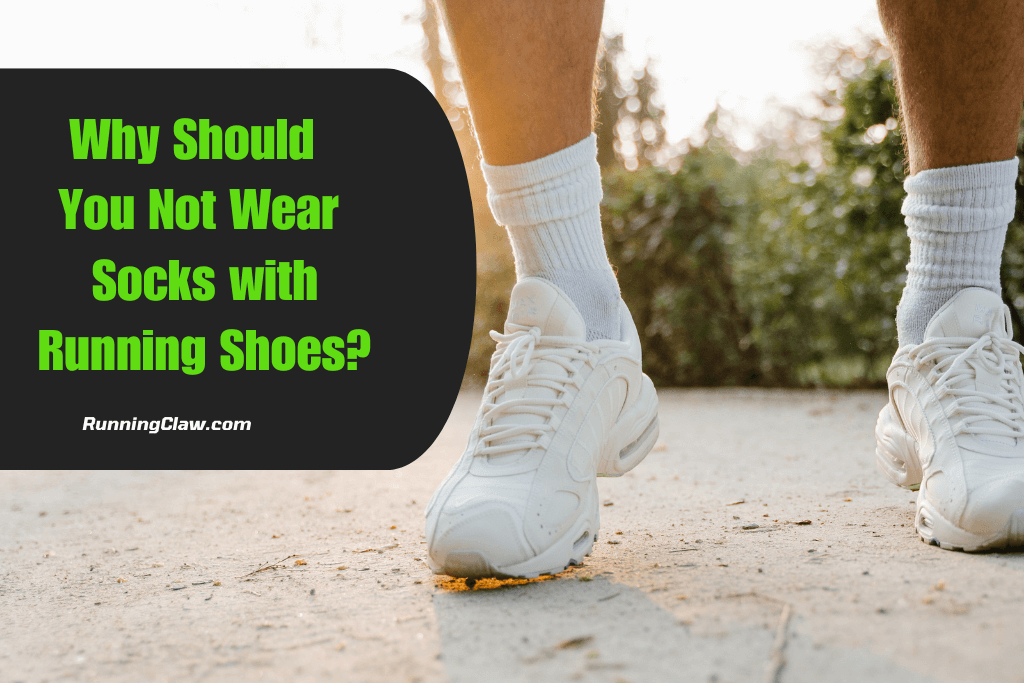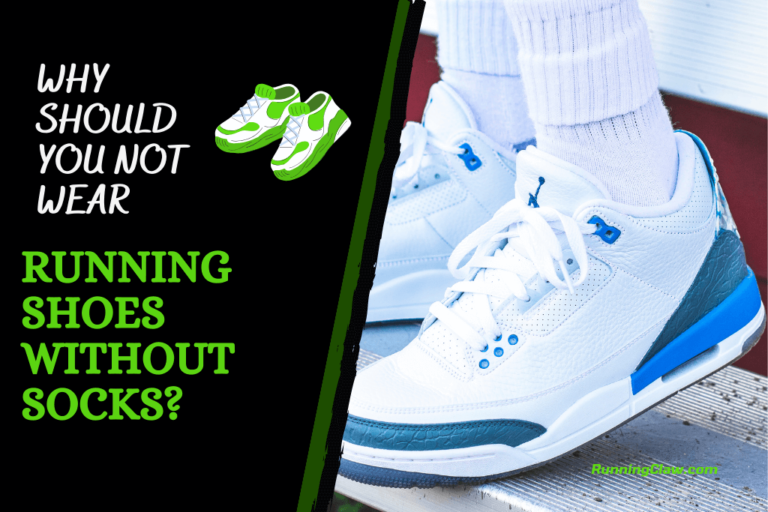Wearing socks for multiple hours could be difficult in summer. Some people do not prefer wearing socks with Shoes in summer.
Socks provide a specific grip and support different physical activities, especially Running.
Do you need to wear Socks for Running?
Or
Is it possible to run without Socks?
Or
Why is it Prohibited to Run Without Socks?
These are the most searched queries. So, I will guide you all about Wearing Socks for Running; its Advantages and Disadvantages.
Please stick to the Article and Read It Whole.
Is it OK to wear running shoes without socks?

Running shoes can be quite costly. Choosing not to wear socks can lead to the accumulation of sweat and bacteria within your shoes, resulting in unpleasant odors and causing them to become dirty and worn over time. To ensure the protection of your new shoes, it is advisable to wear socks consistently when wearing them.
Read this | Squatting in running shoes:Is it Good or Bad?
Why Should I Wear Socks with Running Shoes?
There are many valid reasons why you should wear Socks with Running Shoes. Here are a few:
Prevention from Rubbing:
Wearing the right pair of running socks can make a difference in avoiding uncomfortable rubbing, chafing, and blisters. There are two reasons for this.
So, when you go for a run, it’s normal for your feet to get sweaty. But no worries! If you wear socks made from a fabric that wicks away moisture and dries quickly, along with some breathable shoes, it’ll help that moisture escape and keep your feet feeling fresh.
Oh, I get what you mean! Going without sock while running can make your feet all sweaty and yucky inside your shoes. Plus, it can create more friction, which is not fun. It’s a good idea to keep your feet a bit dryer to reduce rubbing.
Also, remember that regular trail running or road running shoes may not be designed to be worn directly against your skin. This means there might be areas that could rub against your skin without the protection of a sock.
Cushioning:
A good pair of running socks may contain additional padding in the places where your foot makes the greatest contact with your shoe, such as around the heel and ball. They also put a layer of fabric between your foot and your shoe.
Did you know that wearing the right socks can help reduce rubbing, and blisters and relieve pain during those long runs? You might consider checking out models like the Inov-8 speed sock high for extra comfort. It could make a big difference!
Smell Control:
The utilization of socks additionally reduces the presence of odor-causing germs within the insole and top regions of one’s footwear. When socks are worn, the sock material absorbs a significant portion of the bacteria present. Subsequently, these bacteria-laden socks are typically placed in a washing machine, contributing to maintaining relatively odor-free feet and shoes.
This practice is particularly appreciated by individuals who habitually leave their shoes in communal areas, as it minimizes unpleasant odors that may affect their housemates and coworkers.
The unpleasant odors emanating from footwear may not be perceived as a catastrophic issue; however, it is important to note that wearing shoes without socks can create an environment conducive to the proliferation of fungal infections such as athlete’s foot.
Additionally, there is a possibility that you may find yourself in a situation where you have to clean your shoes more frequently, resulting in a higher frequency of shoe replacements. Consequently, this would incur additional expenses for you.
Warmth:
In the summer season, jogging barefoot can be a pleasurable experience. However, during the colder months, while encountering freezing puddles, it becomes advantageous to utilize running socks crafted from merino wool, such as the Darn Tough No Show Tab Ultra-Lightweight Jogging Socks. These socks serve the purpose of offering an essential layer of insulation.
Why Should You Not Wear Socks with Running Shoes?

Well, if you do not like wearing Socks with Running Shoes, here are some for you.
Ability to Run Faster:
Certain track runners and sprinters opt out of wearing socks to avoid the additional weight caused by the presence of extra material.
The existing body of research does not provide definitive evidence to support or refute this concept; however, individuals may choose to personally experiment with it. Does wearing socks impact your speed?
Cooler in Summer:
Running in the heat is miserable, as anyone who has done so can attest. The prevailing temperature is excessively high, and respite for one’s feet could yield significant relief. Running without socks can result in a perceptible decrease in foot temperature during hot weather conditions.
Better Fit:
Certain running shoes are specifically developed for individuals who prefer running barefoot, ensuring superior shoe compatibility in such cases. The absence of additional shoe material, such as socks, may enhance comfort levels. However, it should be noted that this assessment is subjective and dependent on individual preferences.
Tips for Wearing Running Shoes without Socks:
Do follow these tips if you have decided to run without wearing Socks.
Start Slowly:
It is widely acknowledged that attempting to run a marathon on the initial day of engaging in sockless running is not advisable. Similar to the process of breaking into running shoes, the act of running without socks necessitates a period of adjustment.
Individuals who choose not to wear socks when running tend to do so over shorter distances. The distance is less than five miles. It is advisable to commence gradually and assess one’s comfort level while engaging in runs of this duration.
This practice can aid in preventing blisters and facilitate the evaluation of one’s preference for running without socks.
If one possesses a strong affinity for this activity, it is advisable to go towards engaging in lengthier running sessions. However, it is crucial to approach this transition gradually, allowing the feet to acclimate to running without using socks.
Use Powders:
One effective strategy for reducing the appearance of blisters and the development of unpleasant odors in footwear is using powder to maintain optimal dryness of the feet. It is advisable to conduct experiments to determine the appropriate quantity of talcum powder to use, considering the running activity’s distance.
An increase in perspiration diminishes the efficacy of the powder, yet, it may prove to be a particularly advantageous choice during relatively lower ambient temperatures.
Wash Shoes Regularly:
Suppose an individual chooses to engage in running without wearing socks. In that case, it will be necessary to increase the frequency of shoe washing to successfully reduce the presence and growth of bacteria.
This practice can effectively mitigate mold growth and enhance the olfactory experience of one’s footwear.
This holds particularly true for the shoe inserts since they are the component that directly touches the foot in the absence of socks.
Top Sockless Running Shoes:
Here are some of the Running Shoes which you can wear without Socks.
Atreyu The Artist:
This $100 super shoe is carbon-plated. Think about it. Better still, $100 gets you good carbon-soled super-Shoes. TL;DR: Atreyu has quietly made simple, well-crafted running shoes for years, and its new six-ounce racing model outperformed shoes twice the price.
The soft, supple inner lets you run sockless (the founder is a triathlete). Bonus: The heel tab makes these race-day-ready.
Hoka Mach Supersonic:
The Mach Supersonic rapidly enhances Hoka’s Mach model if one desires a more commonplace alternative to the abovementioned Atreyus.
Although lacking a carbon plate in certain models of the Hoka lightweight trainer/racer line, this shoe offers a substantial amount of cushioning without excessively diminishing the overall running experience.
Regarding tri-use functionality, the inclusion of a sizable heel tab facilitates smooth transitioning, while the utilization of a low-seam mesh upper enhances breathability and accelerates drying, all the while offering a plush interior suitable for activities performed without socks.
Nike Free Run 5.0:
While the Free Run 5.0s may not be suitable for extensive long-distance running, it is difficult to overlook the remarkable comfort provided by the breathable knit material that conforms to the foot, even when worn without socks.
The shoe’s outsole is constructed using Nike’s highly pliable foam material, strategically carved with grooves to enhance the shoe’s inherent flexibility.
This shoe is highly regarded for its comfort and suitability for sprint/Olympic-distance racing and shorter recovery runs, as it lacks any uncomfortable protrusions.
Conclusion:
To Conclude, you may choose to run without socks, depending on your personal preferences. Running without socks in the summer can be a logical choice for triathletes. Additionally, individuals who sweat heavily may also find it appealing.
If you choose to run without socks, avoiding uncomfortable situations such as blisters, shoes filled with bacteria, and unpleasant odors is important.
Related Posts:
- Can i wear running shoes for Boxing
- Can we wear running shoes for party
- Squatting in running shoes
- How to Make Cleats Smell Better
- What Sports Can Use Metal Cleats
- Soccer Cleats Vs. Football Cleats
- Can Soccer Cleats Be Used for Football
- Do Professional Soccer Players get Free Cleats
- Can Soccer Cleats Be Used for Football
- Do Puma Soccer Cleats Have A Warranty
- What is The Difference Between Shoes and Cleats
- Difference Between Soccer and Football Cleats


